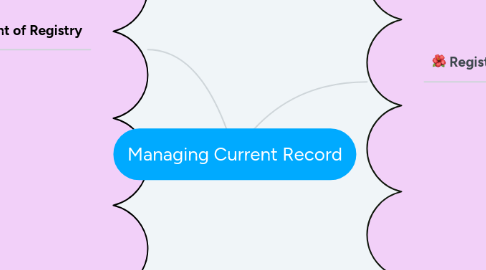
1. Component of Registry
1.1. Mail Management
1.1.1. Information
1.1.1.1. The receiving, sorting, opening, routing, controlling, and distribution of the incoming mail
1.1.1.2. The collecting, sorting and distributing of paperwork coming from within the building or area serviced by the mailroom
1.1.1.3. The collecting, preparing, sorting, controlling and dispatching of outgoing mail
1.1.2. Objective
1.1.2.1. Provide rapid handling
1.1.2.2. Accurate delivery of mail throughout the agency at a minimum cost
1.1.3. Type
1.1.3.1. Mail Room
1.1.3.2. File Management
1.1.4. File Management
1.1.4.1. Information
1.1.4.1.1. File Room Operations
1.1.4.2. Functions
1.1.4.2.1. Filing the records
1.1.4.2.2. Verifying the records to be filed and maintaining an accuracy control
1.1.4.2.3. Issuing the records in the form of files
1.1.4.2.4. Controlling the location of the issued files
1.1.4.2.5. Operating a “Keep In View” system
1.1.4.2.6. Maintaining the record physically. i.e. the files and the file containers
1.1.4.2.7. Finding the records on demand
1.1.4.3. The File Room Aspect
1.1.4.3.1. Should be kept with a clean, neat and orderly appearance
1.1.4.3.2. All flat surfaces should be kept clean and clear of material except while an operation is being performed
1.1.4.3.3. The file cabinets or the modular shelf filing must be maintained with orderliness.
1.1.4.3.4. Avoid crowded of file cabinet rows, drawers or shelf bays
1.1.4.3.5. Charge-out and other control guides must be properly maintained because they act as location file number guide within the particular unit of the file containers.
1.1.5. Mail Room
1.1.5.1. Information
1.1.5.1.1. A space or room in an agency allocated
1.1.5.1.2. Provides a vital service to the department or agency
1.1.5.1.3. The flow of mail, documents, files and other paperwork in 3 channels must be maintained
1.1.5.2. Space and Layout
1.1.5.2.1. Refers to the physical arrangement of all mail rooms and their facilities of furniture and equipment
1.1.5.3. Basic considerations for layout
1.1.5.3.1. Reduction in the distances required for the movement of mail and the motions of personnel processing it
1.1.5.3.2. The rate at which work flows through the unit
1.1.5.3.3. The use of all space as effectively as possible in both horizontal and vertical directions
1.1.5.3.4. Flexibility so that rearrangements can be readily introduced to meet changing demands
1.1.5.3.5. Convenience for servicing and maintenance
1.1.5.3.6. Adequate security
2. Registry
2.1. Introduction
2.1.1. Unit within
2.1.1.1. Organisation
2.1.2. Basically responsible
2.1.2.1. Managing the record
2.1.3. Function
2.1.3.1. Keep on changing with the times
2.1.4. Ensures that
2.1.4.1. A good flow of recorded info in organization
2.2. Functions
2.2.1. To house the entire series of records kept
2.2.1.1. A particular department
2.2.1.2. To have intellectual control over the record
2.2.1.3. Dispatching and receiving
2.2.1.3.1. All letters
2.2.1.4. Monitor the movement of records or file
2.2.1.5. Ensure the action to be taken on a file
2.2.1.5.1. Brought to the attention of the staff concerned
2.2.1.6. A registry keep track with record life cycle
2.2.1.6.1. Physically segregate the file according to the record life cycle
2.2.1.6.2. Prepare an updated list of files to be destroyed
2.3. Centralized
2.3.1. Control comes
2.3.1.1. One location to control the following components
2.3.1.1.1. The records system
2.3.1.1.2. The records staff
2.3.1.1.3. The allocated space for the registries
2.3.1.1.4. The records equipment and supplies
2.3.2. Advantages
2.3.2.1. Intellectual control over the records created
2.3.2.1.1. Uniform policy direction
2.3.2.1.2. Centralized mail operations
2.3.2.1.3. Centralized messenger services
2.3.2.1.4. Uniform classification scheme
2.3.2.1.5. Uniform procedural practices
2.3.2.1.6. Uniform file operations
2.3.2.1.7. Uniform scheduling
2.3.2.1.8. Disposal standards
2.3.2.1.9. Practice
2.3.2.2. Standard procedures
2.3.2.2.1. Record management
2.3.2.3. Control over records creation
2.3.2.3.1. A file design
2.3.2.4. Keeping of records
2.3.2.4.1. Evolve
2.3.2.5. Saving in terms
2.3.2.5.1. Manpower
2.3.2.5.2. Equipment
2.3.2.6. Confidentially of information
2.3.2.6.1. More easily safeguarded
2.3.2.7. Information hogging
2.3.2.7.1. Difficult
2.4. Decentralized
2.4.1. Information
2.4.1.1. There are various units or divisions within a department
2.4.1.2. Various registries will have their own
2.4.1.2.1. Records systems
2.4.1.2.2. Records staff
2.4.1.2.3. Allocated space
2.4.2. Advantages
2.4.2.1. Easy access to information
2.4.2.2. Faster
2.4.2.2.1. Retrieval
2.4.2.2.2. Speedier decision making
2.4.2.3. Saving
2.4.2.3.1. Cost labor
2.4.2.3.2. Expensive equipment
